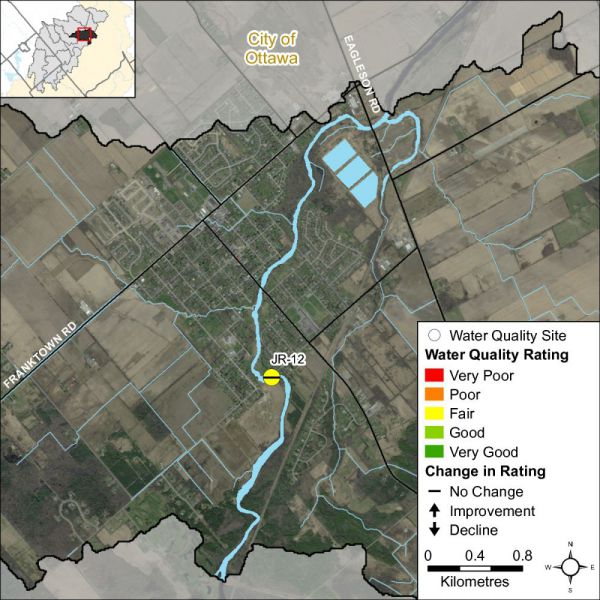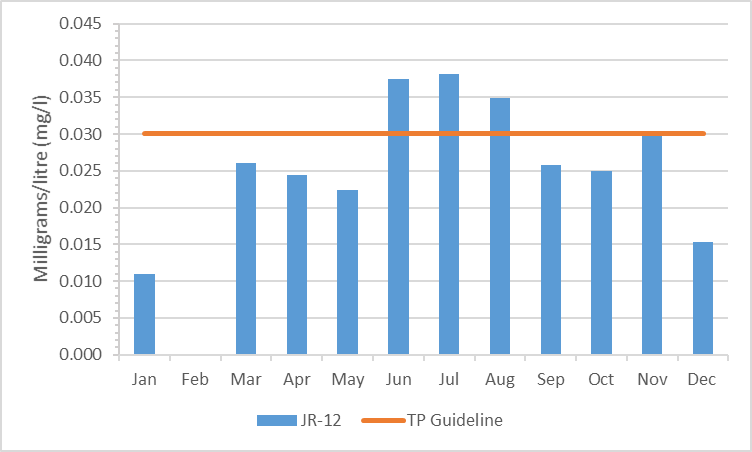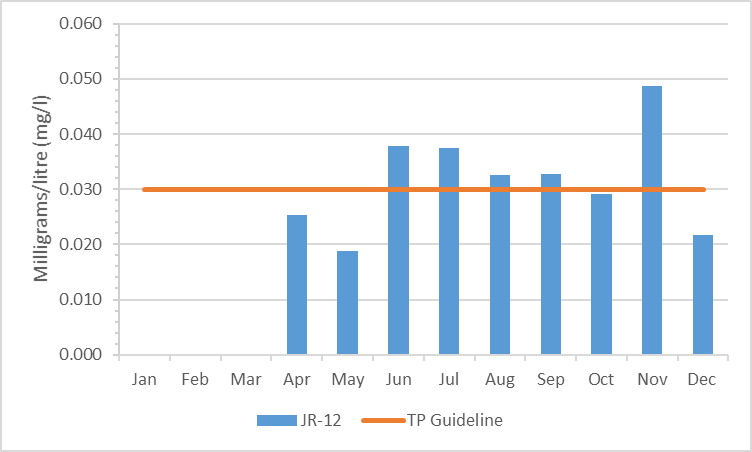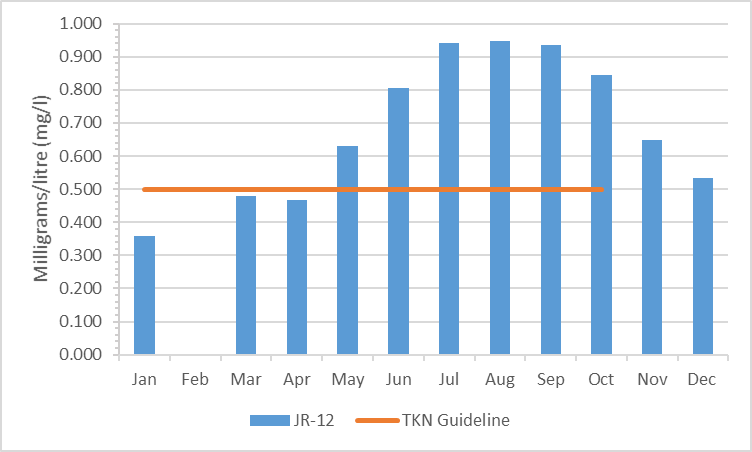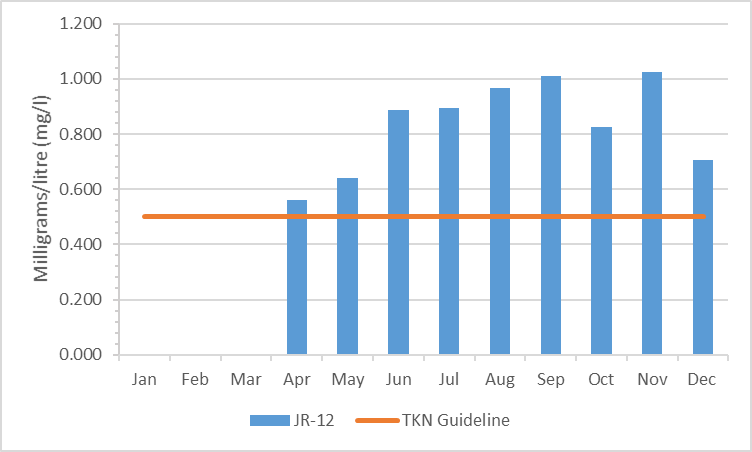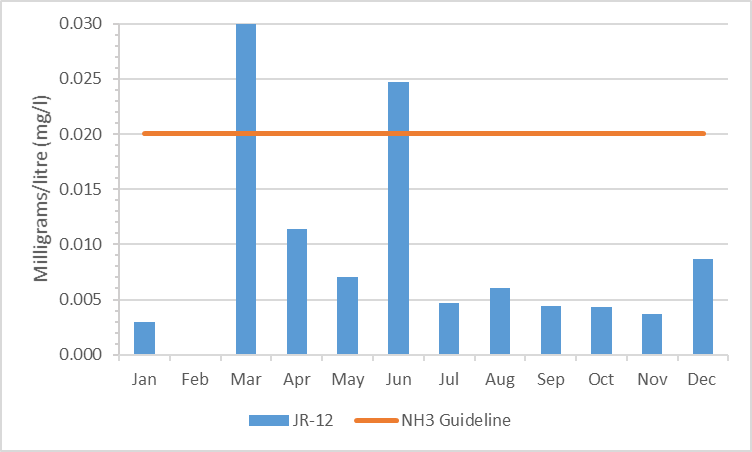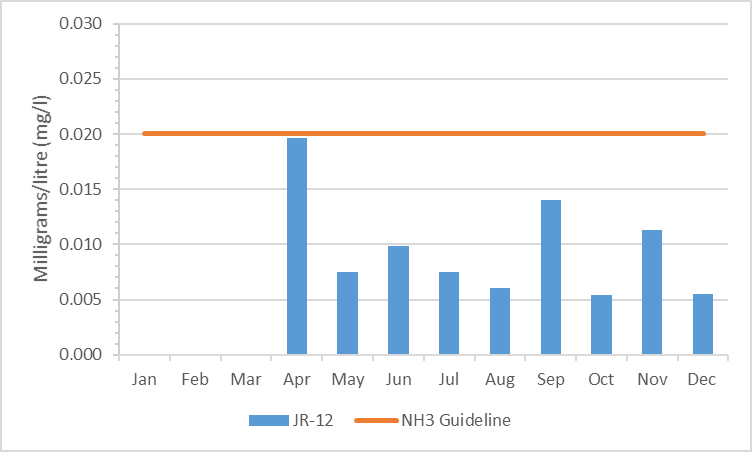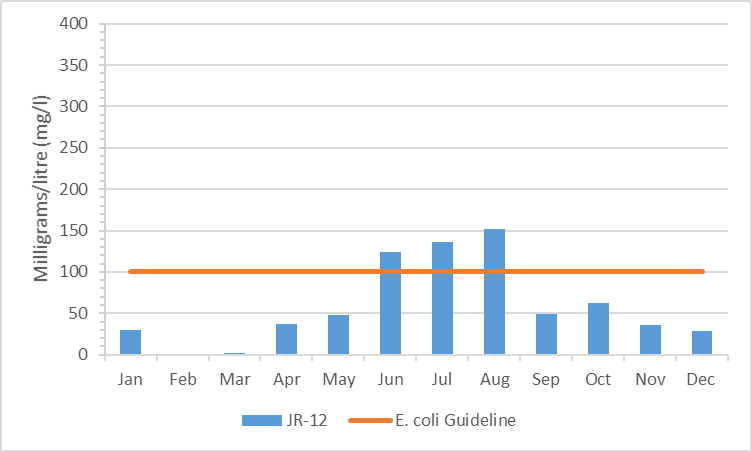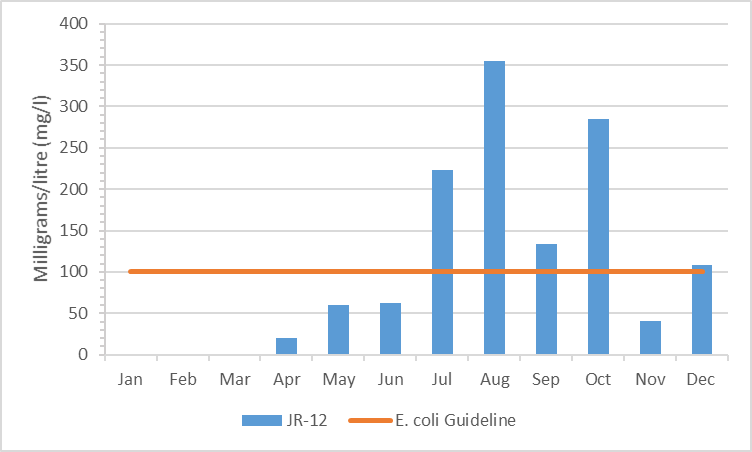2.0 Jock River-Richmond Catchment: Surface Water Quality Conditions
Surface water quality conditions in the Jock River-Richmond catchment are monitored by the City of Ottawa Baseline Water Quality Monitoring Program. This program provides information on the condition of Ottawa’s surface water resources; data is collected for multiple parameters including nutrients (total phosphorus, total Kjeldahl nitrogen and ammonia), E. coli, metals (like aluminum and copper) and additional chemical/physical parameters (such as alkalinity, chlorides, pH and total suspended solids). The locations of monitoring sites are shown in Figure 2 and Table 1.
2.1 Jock River Water Quality Rating
The RVCA's water quality rating for this site (JR-12) is “Fair” (Table 1) as determined by the Canadian Council of Ministers of the Environment (CCME) Water Quality Index. A “Fair” rating indicates that water quality is usually protected but occasionally threatened or impaired; conditions sometime depart from natural or desirable levels. Each parameter is evaluated against established guidelines to determine water quality conditions. Those parameters that are more likely to exceed guidelines are presented below. Analysis of the data has been broken into two periods; 2004 to 2009 and 2010 to 2015 to examine if conditions have changed between these periods. Table 1 shows the overall rating for the monitored surface water quality site within the Jock River-Richmond catchment and Table 2 outlines the Water Quality Index (WQI) scores and their corresponding ratings.
There is one monitored water quality site on the Jock River within the Jock River-Richmond Catchment (JR-12, Figure 2). The water quality score at this site reflects few exceedances across measured parameters with occasional instances of elevated nutrients and bacterial counts. For more information on the CCME WQI, please see the Jock River Subwatershed Report.
| Sampling Site | Location | 2004-2009 | Rating |
|---|---|---|---|
| JR-12 | Jock River at 6197 Ottawa St (dead-end), south of Fowler St. | 73 | Fair |
| Sampling Site | Location | 2010-2015 | Rating |
| JR-12 | Jock River at 6197 Ottawa St (dead-end), south of Fowler St. | 75 | Fair |
| Rating | Index Score |
|---|---|
| Very Good (Excellent) | 95-100 |
| Good | 80-94 |
| Fair | 65-79 |
| Poor (Marginal) | 45-64 |
| Very Poor (Poor) | 0-44 |
2.2 Nutrients
Total phosphorus (TP) is used as a primary indicator of excessive nutrient loading and may contribute to abundant aquatic vegetation growth and depleted dissolved oxygen levels. The Provincial Water Quality Objective (PWQO) is used as the TP Guideline and states that in streams concentrations greater than 0.030 mg/l indicate an excessive amount of TP.
Total Kjeldahl nitrogen (TKN) and ammonia (NH3) are used as secondary indicators of nutrient loading. RVCA uses a guideline of 0.500 mg/l to assess TKN[1] and the PWQO of 0.020 mg/l to assess NH3 concentrations in the Jock River.
Tables 3, 4 and 5 summarize average nutrient concentrations at monitored sites within the Jock River-Richmond catchment and show the proportion of results that meet the guidelines.
| Total Phosphorous 2004-2009 | |||
|---|---|---|---|
| Site | Average (mg/l) | Below Guideline | No. Samples |
| JR-12 | 0.029 | 58% | 52 |
| Total Phosphorous 2010-2015 | |||
| Site | Average (mg/l) | Below Guideline | No. Samples |
| JR-12 | 0.032 | 64% | 44 |
| Total Kjeldahl Nitrogen 2004-2009 | |||
|---|---|---|---|
| Site | Average (mg/l) | Below Guideline | No. Samples |
| JR-12 | 0.756 | 13% | 52 |
| Total Kjeldahl Nitrogen 2010-2015 | |||
| Site | Average (mg/l) | Below Guideline | No. Samples |
| JR-12 | 0.830 | 2% | 44 |
| Ammonia 2004-2009 | |||
|---|---|---|---|
| Site | Average (mg/l) | Below Guideline | No. Samples |
| JR-12 | 0.009 | 96% | 51 |
| Ammonia 2010-2015 | |||
| Site | Average (mg/l) | Below Guideline | No. Samples |
| JR-12 | 0.010 | 89% | 44 |
Monitoring Site JR-12
Elevated TP results were a common occurrence at site JR-12 and stayed fairly consistent between the two monitoring periods. Fifty-eight percent of samples were below the guideline in the 2004-2009 period (Figure 3); this improved slightly to 64 percent of samples in the 2010-2015 period (Figure 4). The average TP concentration increased marginally from 0.029 mg/l (2004-2009) to 0.032 mg/l (2010-2015) as shown in Table 3.
The bulk of TKN results have exceeded the guideline (Figure 5 and 6), with 13 percent of samples below the guideline in the 2004-2009 period, decreasing to only two samples below the guideline in 2010-2015. The average concentration was elevated and increased from 0.756 mg/l to 0.830 mg/l (Table 4).
The results for NH3 showed few exceedances occurred. Ninety-six percent of results were below the guideline in 2004-2009 (Figure 7); this decreased to 89 percent in the 2010-2015 reporting period (Figure 8). The average NH3 concentration increased marginally from 0.009 mg/l to 0.010 mg/l (Table 5).
Summary
Nutrient enrichment is a feature in this reach of the Jock River. The Jock River was previously identified as having a marginal rating (i.e. exceeded targets occasionally) for phosphorus (City of Ottawa, Water Environment Protection Program , 2006). Overall, average nutrient concentrations have remained consistent through the monitoring periods. The elevated TKN concentrations and low NH3 results provide evidence that nutrient enrichment may be a natural feature in this part of the river. Upstream of JR-12 there is little development and large wetland areas which likely contribute to high levels of organic nutrients, such as TKN. Elevated nutrients may contribute to nutrient loading downstream and to the Rideau River.
High nutrient concentrations can help stimulate the growth of algae blooms and other aquatic vegetation in a waterbody and deplete oxygen levels as the vegetation dies off. Best management practices such as minimizing storm water runoff, enhanced shoreline buffers, preventing the use of fertilizers and restricting livestock access should all be employed to prevent unnecessary nutrient loading to downstream reaches.
2.3 Escherichia coli
Escherichia coli (E. coli) is used as an indicator of bacterial pollution from human or animal waste; in elevated concentrations it can pose a risk to human health. The PWQO of 100 colony forming units/100 millilitres (CFU/100 ml) is used. E. coli counts greater than this guideline indicate that bacterial contamination may be a problem within a waterbody.
Table 6 summarizes the geometric mean[2] for the monitored site on the Jock River within the Richmond catchment and shows the proportion of samples that meet the E. coli guideline of 100 CFU/100 ml. The results of the geometric mean with respect to the guideline for the two periods, 2004-2009 and 2010-2015, are shown in Figures 9 and 10.
| E. coli 2004-2009 | |||
|---|---|---|---|
| Site | Geometric Mean (CFU/100ml) | Below Guideline | No. Samples |
| JR-12 | 61 | 69% | 51 |
| E. coli 2010-2015 | |||
| Site | Geometric Mean (CFU/100ml) | Below Guideline | No. Samples |
| JR-12 | 91 | 52% | 44 |
Monitoring Site JR-12
E. coli counts at site JR-12 were occasionally elevated. The proportion of samples below the guideline decreased from 69 percent (Figure 9) from 2004-2009 to 52 percent (Figure 10) from 2010-2015. The geometric mean also increased between the two monitoring periods from 61 CFU/100ml to 91 CFU/100ml (Table 6).
Summary
Bacterial contamination does not appear to be a significant problem in this reach of the Jock River, however due to the apparent increase in counts between the two time periods it should be given greater concern. Best management practices such as enhancing shoreline buffers, restricting livestock access and minimizing storm water runoff can help to protect this reach of the Jock River into the future.
1 No Ontario guideline for TKN is presently available; however, waters not influenced by excessive organic inputs typically range from 0.100 to 0.500 mg/l, Environment Canada (1979) Water Quality Sourcebook, A Guide to Water Quality Parameters, Inland Waters Directorate, Water Quality Branch, Ottawa, Canada
2A type of mean or average, which indicates the central tendency or typical value of a set of numbers by using the product of their values (as opposed to the arithmetic mean which uses their sum). It is often used to summarize a variable that varies over several orders of magnitude, such as E. coli counts
